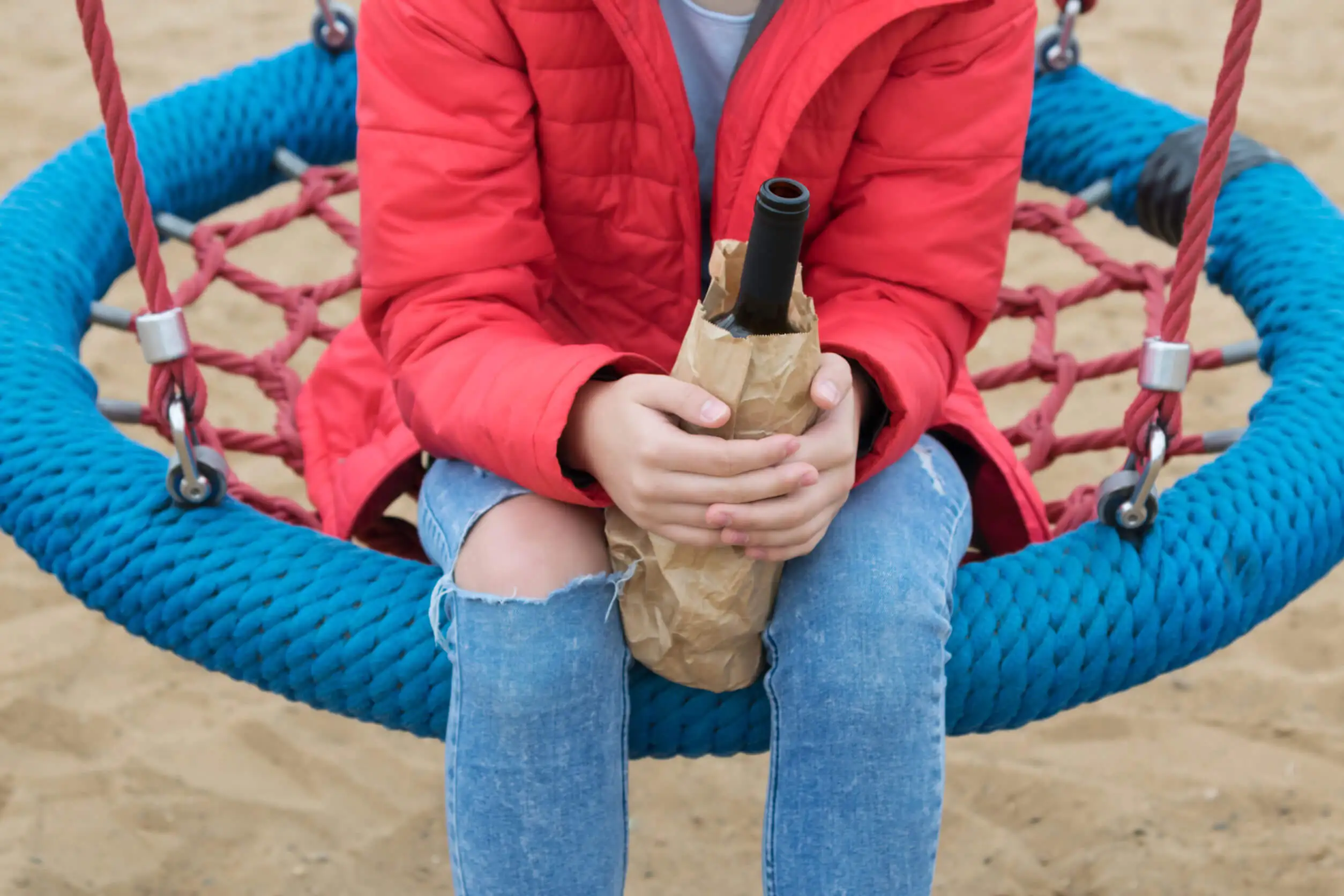Alcoholism in Adolescents: Everything You Need to Know


Written and verified by the psychologist Elena Sanz
Alcohol consumption is seen as quite normal in our society, even being perceived as a desirable activity. Alcoholic beverages are present in many different types of situations and are a must-have in many celebrations and gatherings of family and friends. If alcohol poses risks for adults, then imagine how much more serious alcoholism in adolescents can be.
It is estimated that more than 76% of adolescents have consumed alcohol at some time in their lives and almost 28% have been drunk in the last month. Consuming alcoholic beverages is very common among the adolescent population and the first consumption is occurring at increasingly younger ages.
In view of this data, it’s imperative that parents take preventive measures to ensure their children don’t suffer from the short and long-term consequences. If you don’t know how to begin to address the issue, here’s everything you need to know about it.
What are the causes of alcoholism in adolescents?
For prevention to be effective, it’s important to understand the reasons that lead young people to consume alcohol. First of all, there’s no doubt that the normalization of consumption and easy access are key points.
In this way, young people not only underestimate the risks, but they can also get hold of alcoholic beverages easily. On the other hand, the very nature of adolescence can contribute to consumption for several reasons:
- The young person seeks to break away from parental values and defiant attitudes are frequent. Thus, the consumption of alcohol can be considered an act of rebellion.
- The need to be accepted by peers and to be part of the group grows. Because of this, social pressure exerts a great influence.
- Adolescence is a time of great change that can overwhelm the young person. Alcohol can be a way to try and forget about suffering, as well as to overcome fears and limitations.
- A feeling of invulnerability appears, leading the teenager to think that they won’t be affected by any of the consequences of alcohol.
But in addition, there are certain phenomena that cause alcoholism to be maintained and can become chronic. It has been found that young people are much less sensitive to the sedative and aversive effects of alcohol. On the other hand, they experience the reinforcing effects to a greater extent than adults.
For the same reason, they don’t have the barriers that can limit how much adults consume. For them, in the short term, the advantages outweigh the disadvantages.

The risks and health consequences of alcoholism in adolescents
The damage that excessive alcohol consumption can cause to the body is well known. However, when we’re talking about adolescents, because they’re still developing and growing, the consequences can be far more serious.
First of all, alcohol alters the hormonal action of puberty and affects growth. But, above all, the main consequences occur at the psychosocial level.
Brain development isn’t complete by the time adolescence occurs, so alcoholism in adolescents affects their cognitive abilities. The prefrontal cortex (responsible for reasoning, planning, and decision-making) continues to mature for several more years.
Similarly, attention, memory, and learning can be seriously impaired, and the more frequent and prolonged the consumption of alcohol by the young person, the greater the consequences. In addition, certain psychological conditions (anxiety, depression, and low self-esteem) may appear to a greater extent in these cases.
As if this weren’t enough, it has been shown that the age at which alcohol is consumed is significantly related to the risk of developing problematic consumption or addiction. Thus, the earlier drinking begins, the greater the risk of dependence.
Find out more: The Causes of Alcoholism: Consequences and Treatment
Other problems that can be triggered by alcohol consumption
In addition to the direct effects on the physical and mental health of adolescents, alcohol consumption can trigger a series of indirect problems derived from a lack of ability to control impulses.
- Increased likelihood of risky sexual behavior and, as a result, of disease transmission (STD) or unwanted pregnancies.
- Increased aggressiveness and violent behavior towards family members, partners, or romantic partners.
- An increased risk of car or other accidents.
- An increased possibility of consuming other substances, such as drugs, and developing an addiction to them.

Another interesting article for you: What Happens When you Drink Alcohol On An Empty Stomach
Data on adolescent alcohol consumption
Worldwide, more than 25% of all young people consume alcoholic beverages, which, according to the Global Status Report on Alcohol and Health 2018, would be 155 million adolescents. Europe has the highest rates of alcohol consumption among young people, at 43.8%. The Americas follow it with 38.2% and the Western Pacific with 37.9%.
Alcohol consumption begins before the age of 15 and is almost equally prevalent among girls and boys, ranging from 50 to 70%.
With respect to the total population, excessive alcohol consumption is lower in young people between 15 and 19 years of age, but, worryingly, between 20 and 24 years of age is the section of the population that consumes the most alcoholic beverages. In the world as a whole, except in the Eastern Mediterranean Region, heavy episodic drinking is higher in 15-24-year-olds than in the total population.
As for women, in many regions, the number is declining, except in Southeast Asia and the Western Pacific. However, the absolute number of women drinking has been increasing.
In an article in Gaceta Sanitaria, January-February 2021, Trends in alcohol consumption among school-aged adolescents in Spain (article in Spanish, abstract in English) the results are more encouraging, showing an overall decline between 2010 and 2018. The downward trend is significant, “but it should be noted that between 2014 and 2018, similar levels of frequent alcohol consumption are maintained in all groups except boys aged 15-16 years.”
Warning signs of alcohol consumption in adolescents
Adolescence is a stage characterized by changes and development. Therefore, some changes in a young person’s behavior are, to a certain extent, to be expected.
However, there can be behavior or actions that don’t correspond to the normal developmental process, and which may indicate problems with alcohol. Therefore, parents, caregivers, and teachers should be aware of the warning signs that may indicate underage drinking.
The most common ones are:
- Changes in mood, with frequent irritability
- Rebelliousness and disobedience
- Low energy levels
- Less care for appearance
- When the young person consumes alcohol, you can usually notice the smell of alcohol on the breath, coordination problems, and slurred speech
- Finding alcohol in the adolescent’s belongings
- Their group of friends also consume alcohol
How to prevent alcoholism in adolescents
To prevent alcoholism in adolescents it’s essential that certain measures are taken at home. Despite the existence of prevention campaigns in the media or in schools, parents have a responsibility that includes the following points:
- To enhance the teenager’s self-esteem and security from the early years so that they can make decisions based on their own values.
- Working on social skills and assertive communication, so that alcohol isn’t necessary as a means of disinhibition and socializing.
- Talking to the adolescent about the health risks of drinking alcohol. Instead of prohibiting and demonizing it, explain to them why it’s important to delay consumption at least until their body and brain have developed.
- Offering healthy leisure alternatives and promoting the company of other teenage friends who share the same values. Sports or art are very appropriate activities to devote their free time to.
- Setting an example with your own behavior. It’s inconsistent to explain to a young person the serious risks of alcohol while their parents consume it daily or without moderation.
The role of parents with regard to alcohol consumption
Parents and caregivers often play a very important role in shaping attitudes concerning alcohol consumption. Therefore, it’s important for parents and caregivers to play an important role:
- Being role models. Therefore, try to be responsible in your alcohol consumption so that the child or adolescent doesn’t consider it to be normal.
- Preventing alcohol from being easily accessible to minors.
- Supervising gatherings and parties to avoid alcohol consumption.
- Encouraging minors to participate in healthy and fun activities that don’t involve alcohol.
Ultimately, teen drinking can be extremely harmful, leading to serious long-term consequences. So, if you have children who are about to enter puberty, take advantage of any opportunities you get to start talking to them. Having the right information will help them to make better decisions.
All cited sources were thoroughly reviewed by our team to ensure their quality, reliability, currency, and validity. The bibliography of this article was considered reliable and of academic or scientific accuracy.
- Ahumada-Cortez, J. G., Gámez-Medina, M. E., & Valdez-Montero, C. (2017). El consumo de alcohol como problema de salud pública. Ra Ximhai, 13(2), 13-24.
- Gómez, O. G., Vázquez, Y. E. G., Ojeda, M. A. R., Guerrero, J. L. P., González, E. H., & Carralero, W. J. R. (2019). Comportamiento del alcoholismo en adolescentes. Acta medica del centro, 13(3), 315-327. https://www.medigraphic.com/pdfs/medicadelcentro/mec-2019/mec193d.pdf
- Leal-López, E., Sánchez-Queija, I., Rivera, F., & Moreno, C. (2021). Tendencias en el consumo de alcohol en adolescentes escolarizados en España (2010-2018). Gaceta Sanitaria, 35, 35-41. https://www.gacetasanitaria.org/es-pdf-S0213911119302237
- Organización Panamericana de la Salud 2019 Informe sobre la situación mundial del alcohol y la salud 2018. Resumen OPS/NMH/19-012 https://iris.paho.org/bitstream/handle/10665.2/51352/OPSNMH19012_spa.pdf?sequence=1&isAllowed=y
- Sánchez, L. (2002). Consumo de alcohol en la población juvenil. Adicciones, 14 (Supl. 1), 99-114.
- Pautassi, R. M. (2013). Consumo de alcohol durante la adolescencia y el desarrollo temprano, causas y consecuencias.
This text is provided for informational purposes only and does not replace consultation with a professional. If in doubt, consult your specialist.








